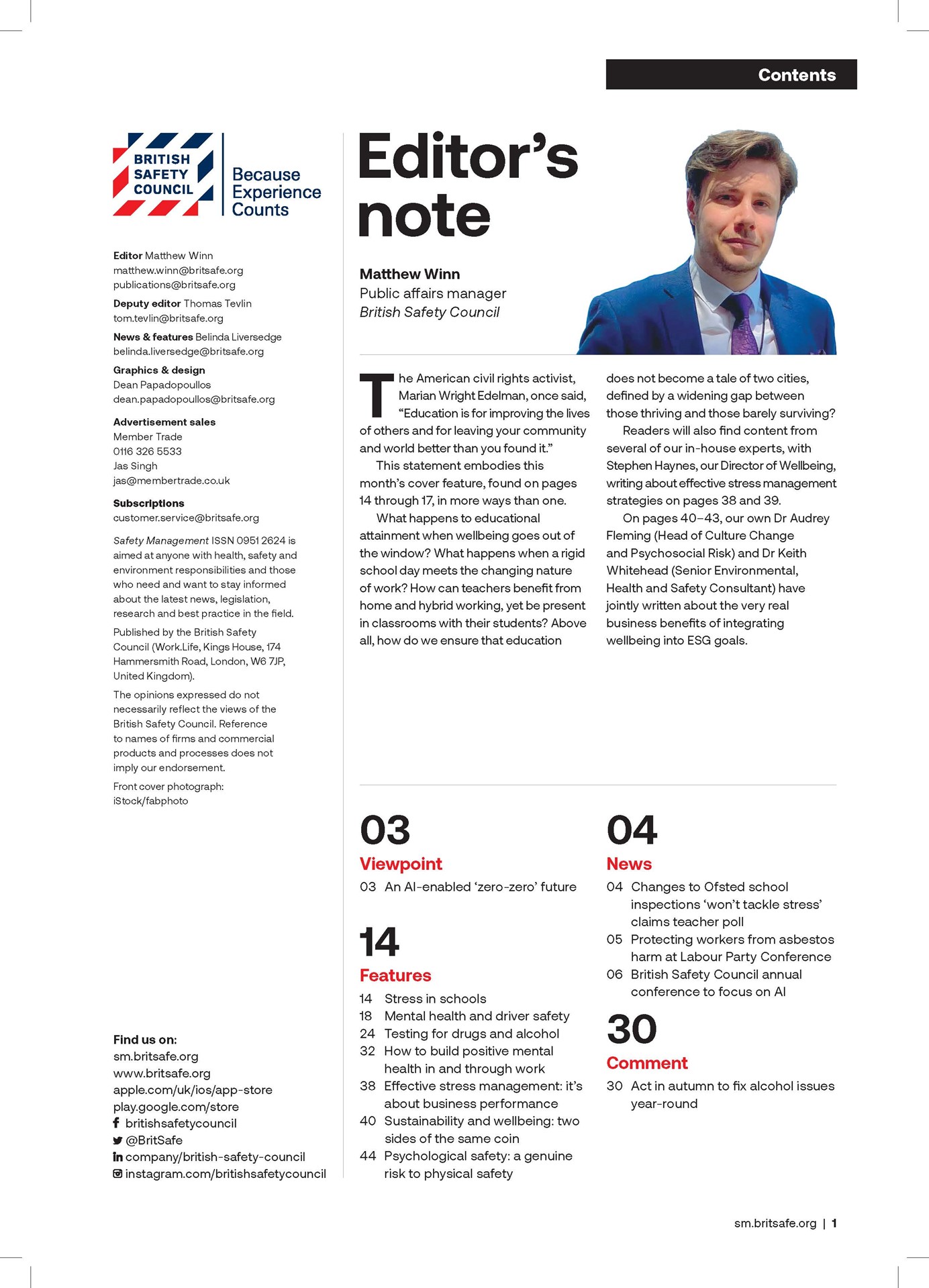Poor public health and long-term sickness absence are placing extreme financial pressure on the UK’s health and social care system and the overall economy. However, by investing in workplace health prevention programmes and education initiatives, employers can help reduce the scale of ill health among the population and minimise the associated costs for society and business alike.
Features
From crisis to prevention: the urgent role of employers in upstreaming health
Britain is sick and facing a deepening health crisis, with an alarming rise in long-term illness and economic inactivity due to health-related issues. But the health crisis is not just a medical issue, it is a serious societal and economic challenge, with implications for public health, the economy and the future of the NHS. Without action, the country will face economic stagnation, an overwhelmed healthcare system and an unsustainable welfare burden.
The economic impact of long-term sickness is profound; £20.6 billion from the public purse annually, with long-term sickness projected to cost £66.3 billion per year by 2030. Eight million people are now reliant on incapacity and disability benefits. As economic inactivity rises, the workforce is shrinking, productivity is declining and pressure on the NHS and social care continues to mount. Forecasts indicate a 50 per cent surge in long-term sickness absence over the next five years; meaning by 2029, up to 4.3 million individuals could be missing from the workforce, posing significant challenges for both employers and the wider economy.
Financial impact
The financial impact of sickness absence on UK employers has risen sharply. In 2023 alone, workplace illness cost businesses an estimated £138 billion, factoring in both absenteeism, employees taking sick leave and presenteeism, where individuals work while unwell but with reduced efficiency. On average, 49.7 days of lost productivity, per UK employee, per year due to poor health, with 7.8 days attributed to formal sick leave, marking the highest sickness absence rate in a decade.
Since 2019, the cost of absence has surged by nearly 50 per cent, with certain sectors, such as hospitality, experiencing a staggering 500 per cent increase. This growing financial strain stems from diminished productivity, temporary staffing needs and rising healthcare expenses.
 Photograph: iStock
Photograph: iStock
Health and life expectancy are deeply interconnected. While medical advancements have prolonged lifespan, the quality of those extra years depends on overall wellbeing. In the UK, life expectancy remains high, with men averaging 79.6 years and women 83.2 years. However, healthy life expectancy; the number of years lived in good health, has stagnated or even declined in recent years, despite improvements in working and living conditions. People are living longer, but with more chronic diseases and ongoing health challenges.
41 per cent of UK adults aged 16 and over had at least one longstanding illness. More than 25 per cent of the adult population in England lives with two or more conditions and this rises to two-thirds of people aged 65 years or over. Multi-morbidity (the presence of two or more long-term health conditions) has emerged as one of the greatest challenges facing health services. Additionally, around one in four adults have faced delays in accessing healthcare over the past year, increasing the risk of conditions worsening due to prolonged waiting times.
The most common chronic conditions were:
- Conditions of the musculoskeletal system (14 per cent)
- Mental, behavioural and neurodevelopmental conditions (11 per cent)
- Conditions of the heart and circulatory system (9 per cent)
- Diabetes and other endocrine and metabolic conditions (8 per cent)
- Conditions of the respiratory system (7 per cent)
- Conditions of the digestive system (5 per cent).
Chronic conditions arise from a complex interplay of genetic, lifestyle and environmental factors, but up to 80 per cent of premature cases of heart disease, stroke, chronic liver disease and type 2 diabetes, along with 40 per cent of cancer diagnoses, could be prevented through healthier lifestyle choices. While diseases like diabetes, heart disease, depression and cancer may never be fully eradicated, proactive strategies can significantly lower their incidence and prevalence, leading to better overall public health outcomes.
Although medications and other interventions can support patients after diagnosis, they cannot fully alleviate all symptoms or guarantee improvements in quality of life or longevity. Maintaining a balanced diet, engaging in regular physical activity and avoiding smoking, excessive alcohol consumption and excessive sun exposure are all highly modifiable behaviours within our control, offering a powerful means to reduce disease risk and improve long-term health outcomes.
The role of employers
Tackling Britain’s health crisis isn’t just the responsibility of the NHS or the government, it also calls for action from employers. Greek physician and philosopher, Hippocrates acknowledged 2,300 years ago that prevention is better than cure. With preventable health, we need to look upstream at early interventions, and not just focus on the treatment of poor health.
We are all able to influence positive change and prevent ill health through early interventions. Businesses play a vital role in prevention, early intervention and creating workplace environments that prioritise health. By investing in employee wellness, employers can help reduce strain on the healthcare system while improving productivity and overall wellbeing.
Addressing the root causes of illness and investing in upstream health strategies will be crucial in reversing this trend and ensuring a healthier, more resilient nation.
 Dr Julie Riggs
Dr Julie Riggs
Addressing the root causes of health challenges
The concept of upstreaming health refers to addressing the root causes of health challenges before they manifest as individual or societal problems. In the UK, where public health initiatives have traditionally focused on reactive healthcare solutions, there is increasing recognition that employers play a crucial role in shifting the focus upstream, prioritising prevention, workplace wellness and social determinants of health.
Downstream
- At the base of the healthcare triangle is downstream care, which focuses on reactive clinical treatment. This approach addresses health conditions after they have developed, including chronic pain management, dialysis for kidney failure and surgery for diagnosed cancers. Such conditions are often long-term and complex, requiring sustained intervention to enhance functioning, improve quality of life and maintain life expectancy as close to the average as possible. While crucial for managing illness, downstream care highlights the importance of prevention and early intervention to reduce the burden of chronic disease.
Midstream
- Midstream is early diagnosis and managing chronic conditions to prevent them from escalating into a more serious issue. Smoking cessation services, health checks from a GP and cervical cancer screenings (smear tests) are a good example. Other examples include use of medications, such as statins to reduce cholesterol and hence reduce the risk of stroke or heart attack. This could be considered a form of harm reduction, as it is aimed at people who appear healthy, but potentially have subclinical forms of disease or pathological features which could lead to them becoming unwell.
Upstream
- At the peak of the health care triangle is upstream intervention, which focuses on prevention, lifestyle promotion and education. This approach aims to reduce disease incidence, ensuring individuals remain healthy rather than requiring treatment later. Upstream strategies include universal measures such as vaccinations to enhance immunity and initiatives that support healthier lifestyles, like balanced nutrition and regular physical activity. These efforts target healthy individuals who have no existing disease, aiming to create environments where wellness is sustained and illness is avoided altogether.
The NHS in the UK spends a significant portion of its £178 billion budget on downstream clinical care and treatment. Recognising the need for a shift towards prevention, the NHS Long Term Plan prioritises early intervention and proactive health strategies to reduce future healthcare demands. Reports indicate that strengthening preventive measures could yield significant cost savings, with estimates suggesting the NHS could save up to £11 billion annually by investing in early intervention initiatives.
Prioritise employee health
Employers have a compelling reason to prioritise employee health, not only to manage costs but to cultivate a workplace where individuals feel genuinely valued. A healthier workforce leads to greater engagement, higher energy levels and improved efficiency, while also reducing accidents and absenteeism. Leadership plays a pivotal role in fostering a culture of wellbeing, demonstrating the organisation’s commitment to employee health through proactive policies and supportive initiatives. When wellbeing is prioritised at the top, it strengthens trust, productivity and overall workplace satisfaction.
Key strategies to adopt include:
- Prioritise preventative care – provide health screenings, flu vaccinations and wellness programs to identify potential health risks early.
- Optimise workplace design – create workspaces that promote movement, natural light, managed sound levels and ergonomic support, helping to minimise strain and fatigue. Create quiet zones and collaborative areas. Integrate biophilic design, by introducing indoor plants, natural materials and greenery to promote mental wellbeing and increase cognitive function.
- Strengthen mental health support – provide training and education on psychological wellbeing, recognising signs and pathways for support. Offer access to employee assistance programmes, stress management resources and flexible work arrangements to build resilience; and build peer support networks focusing on mental health advocacy.
- Encourage healthy lifestyles – encourage active commuting through cycle-to-work schemes, promote healthy eating with nutritious food choices and hydration stations, and foster physical activity with initiatives like standing desks, walking groups and subsidised gym memberships. Engage employees in wellness through interactive health challenges such as daily, weekly and monthly step competitions and prioritise preventative care by providing health and wellbeing screening programmes.
- Address presenteeism – cultivate an environment where employees feel comfortable taking sick leave when necessary, preventing long-term health declines. Promote flexible work arrangements, and conduct wellbeing audits and employee surveys to identify patterns of presenteeism and develop targeted interventions.
- Embed wellbeing into company policies – integrate health priorities into leadership strategies, performance evaluations and workplace benefits.
 Integrating upstream health strategies into workplace policies represents a pivotal shift toward a preventative, holistic approach to health in the UK. Photograph: iStock
Integrating upstream health strategies into workplace policies represents a pivotal shift toward a preventative, holistic approach to health in the UK. Photograph: iStock
Bridging the gap
Occupational safety and health (OSH) practitioners can help bridge the gap between occupational safety and broader public health efforts. We have seen the contribution the health and safety industry made during the COVID-19 pandemic, whereby practitioners played a critical role in protecting workers and ensuring public health measures were effectively implemented.
OSH practitioners possess a diverse set of skills that crossover into various areas of public health, workplace wellness and risk management. Their responsibilities can extend beyond compliance and they can actively contribute to disease prevention, health promotion and emergency preparedness.
Key crossover skills that can be used to support both employee and wider public health that OSH practitioners often already hold, and can further develop, include:
- Risk assessment and prevention – this applies to both occupational health and broader public health efforts, helping mitigate environmental and workplace risks.
- Health and safety education – training employees and communities on best practices and preventative measures, such as healthy diet, exercises, sun protection and healthy habits.
- Emergency preparedness – developing response plans for health crises, including pandemics, environmental hazards and workplace accidents.
Collaboration with public health initiatives – supporting vaccination campaigns, infection control measures and mental health programmes, such as promoting psychological resilience in workplace. - Data analysis and reporting – understanding trends in workplace injuries, absenteeism and illness translates to broader public health surveillance and strategic planning.
Conclusion
Integrating upstream health strategies into workplace policies represents a pivotal shift toward a preventative, holistic approach to health in the UK. By prioritising employee wellbeing, businesses not only foster a healthier workforce but also strengthen long-term sustainability and productivity. This proactive model reduces pressure on the NHS, enhances economic resilience and delivers widespread benefits to communities.
As workplace health continues to evolve, employers will play an increasingly vital role in shaping a healthier future. By championing preventative wellness strategies, UK businesses can lead the transformation of public health – where prevention and resilience drive economic and social progress.
By taking meaningful action, together we could be contributing to the development of a healthier Britain – in body, mind and the purse strings.
Dr Julie Riggs will be speaking at SHW Live London Olympia on Wednesday 18 June on ‘Upstreaming – how can OSH professionals help solve the nation’s health crisis?’ See: safetyhealthwellbeing.live
Dr Julie Riggs is Director of education at the British Safety Council
FEATURES

“I’m not prepared to sit back and assume everybody’s fine”
By Belinda Liversedge on 02 December 2025
Director of health and safety at the Canal & River Trust, Anne Gardner-Aston, shares what she’s most proud of achieving in the past four years since taking on a new role in the wake of a turbulent moment in the charity’s history.

Targeting dust in construction
By Belinda Liversedge on 30 October 2025
Rohan Jindal was cycling to college in Dehli where he was studying engineering, when he had to stop. Not because of the hot sun beating down, but because he couldn’t breathe. And although asthmatic, that wasn’t the trigger. Looking all around he saw construction sites emitting large clouds of dust. This was his ‘a ha’ moment. “What,” he asked himself “do they do in construction to supress the dust?”

Paper vs digital – how CFTS is revolutionising work equipment inspections for members
By Rob Fisher, CFTS on 30 October 2025
A new mobile app makes it easier for CFTS-accredited businesses to manage the delivery of Thorough Examinations of customers’ work equipment, but it also benefits the customer through automated reminders about the safety of their machine and the results of the examinations.



